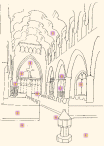
 |
  |
TOMB THAT ALSO SERVES AS SITE OF THE EASTER SEPULCHRE
Anne Harling, wealthy heiress of the Gonville and Harling families, placed her tomb (with that of her first husaband) between the church’s chancel and his chantry. The merchant John Clopton (+ 1494) also did so in the parish chruch of Long Melford. The tombs sat under an open arch and was used for the Holy Week ritual of the Easter Sepulcher. The ceremony involved "burying" the host on Good Friday by putting it in a special place and bringing it out for the "Resurrection" on Easter Sunday. Nightly vigils continued for the faithful from the time of the host's disappearance to its retrieval. By designing a personal tomb that would also function as the Easter Sepulcher, the donor achieved the additional strategy of focusing attention to his or her gift, and also insuring that the most poignant and intense prayers connected with the belief in the Resurrection would "wash over" the tomb itself. On the underside of the arch over Clopton's tomb, as if the deceased could “see,” is an image of the resurrected Christ. Margery Kempe mentions the ceremony of the Easter Sepulchre at St. Margaret’s, Lynn (Ch. 57). See Pamela Sheingorn, The Easter Sepulchre in England (Kalamazoo, Michigan: Medieval Institute Pub. WMU, 1987). 10b East Harling, Sts Peter and Paul, Tomb
of Anne Harling as Easter Sepulchre.
|